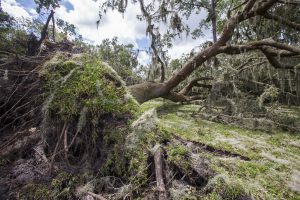Is your farm or ranch prepared for hurricane season? It is important to consider hurricane prep for farms before the storm. As the 2022 hurricane season starts at a leisurely pace, there’s talk of what the rest of the season holds. Taking a proactive approach to disaster planning can help your farm or ranch weather the storm. We know the bread and water shelves are often empty right before a hurricane hits and it takes some time to restock. That may be the case with your farm supplies as well. Farmers and ranchers should have enough supplies to get by for at least a week after experiencing a major storm. Whether you are a hurricane newbie or veteran, here are some helpful tips:
Before the Storm:
- Check that generators and chainsaws are working properly.
- Stock up on fuel for tractors, generators, and other equipment. Don’t forget about mixed fuel for certain equipment.
- Scout for potential debris and secure it before the storm. Be proactive to minimize damages. Bring equipment you may need (chain saw, ladder, toolbox, etc.) to a secure location in or near the house.
- Secure buildings like greenhouses, shops, and barns.
- Create a plan. Determine if you will evacuate – if you do so, leave with enough time to get to safety before the storm. Make sure all animals have current immunizations and Coggins tests to take with you if you evacuate them.
- Locate and protect important paperwork. Insurance, financials, records, etc. can be backed up on computers and paper files can be placed into waterproof containers or bags. Document inventory of farm buildings, vehicles, equipment, and livestock before a disaster occurs (this will help when requesting disaster aid).
- Create a list of emergency contacts including your veterinarian, Farm Service Agency, your employees and their emergency contacts, and utility company.
- Become aware of the FSA Disaster Assistance Programs

Protecting Livestock
- Be sure to check fences and stock up on basic fence repair materials.
- The safest place for livestock is in open pastures with secure fences. It should have high areas to get out of flooding and be away from potential debris and possible downed powerlines. Barns are not always structurally sound to withstand high winds and can collapse, causing animal injury or death.
- Poultry facilities should have adequate ventilation. Provide animals with food and clean water.
- Add identification to livestock in case of downed fences. A registered brand is your best bet, but luggage tags braided into tails or manes, ear tags with contact information, or even a paint stick/non-toxic spray paint can be used to mark the animals with your contact information.
- Have an emergency supply box accessible with halters, leads, tape, rope, tarps, fly spray, and animal medical supplies.
- Stock up on extra feed and water. This includes livestock feed as well as your farm dog/cat food. Wandering animals may be deprived of food and water for extended periods. Water is essential.
After the Storm:
- Document any losses or damages. Save receipts for repairs and clean up services. These will be needed for insurance claims and federal disaster programs.
- Be cautious of downed powerlines. Do not exit your vehicle if you are near a downed powerline. Contact your utility company or emergency personnel.
- Report damage and losses to your Farm Service Agency. Depending on your request, reporting may be required as early as 72 hours after the storm to be eligible for disaster assistance. For more information on disaster assistance programs, visit: https://www.farmers.gov/protection-recovery/hurricane
For more information on hurricane preparedness: https://sfyl.ifas.ufl.edu/archive/hot_topics/disaster_prep/hurricane_prep_ag.shtml
 0
0
